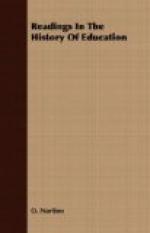(1) The Code, in twelve books, which contains statutes of the Emperors from the third century A.D.
Since [says Justinian] we find the whole course of our statutes ... to be in a state of such confusion that they reach to an infinite length and surpass the bounds of all human capacity, it was therefore our first desire to make a beginning with the most sacred Emperors of old times, to amend their statutes, and to put them in a clear order, so that they might be collected together in one book, and, being divested of all superfluous repetition and most inequitable disagreement, might afford to all mankind the ready resource of their unalloyed character.[25]
(2) The Digest, or Pandects, in fifty books, containing extracts from the opinions of Roman lawyers on a great variety of legal questions. This work was also undertaken to bring order and harmony out of the prevailing confusion:
We have entrusted the entire task to Tribonianus, a most distinguished man, Master of the Offices, ex-quaestor of our sacred palace, and ex-consul, and we have laid on him the whole service of the enterprise described, so that with other illustrious and learned colleagues he might fulfil our desire. [He is] to collect together and to submit to certain modifications the very most important works of old times, thoroughly intermixed and broken up as they may almost be called. But in the midst of our careful researches, it was intimated to us by the said exalted person that there were nearly two thousand books written by the old lawyers, and more than three million lines were left us by them, all of which it was requisite to read and carefully consider and out of them to select whatever might be best. [This was accomplished] so that everything of great importance was collected into fifty books, and all ambiguities were settled, without any refractory passage being left.[26]
In mediaeval university documents the Digest is frequently mentioned in three divisions, which probably indicate three separate instalments in which the MS. of the work was brought to Bologna in the eleventh and twelfth centuries: the Old Digest (Digestum Vetus) Bks. I-XXIV, title ii, Infortiatum Bks. XXIV, title iii-XXXVIII, title iii, and New Digest (Digestum Novum) Bks. XXXVIII, title iv-L. The meaning of the term Infortiatum is uncertain.
This distinction between
the various parts of the Digest is
purely arbitrary....
The division must have originated in an
accidental separation
of some archetypal MS.[27]
(3) The Institutes, in four books, an elementary text-book for students. The purpose of the book was to afford a simple, clear, and trustworthy introduction to the study of law, and to economize the student’s time:




